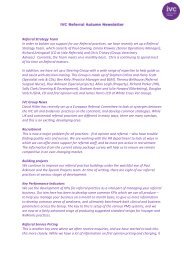Heat stress (Guideline)
Create successful ePaper yourself
Turn your PDF publications into a flip-book with our unique Google optimized e-Paper software.
<strong>Guideline</strong> for the management of <strong>Heat</strong> Stress in Animals<br />
Despite a long running and well recognised campaign by the RSPCA, it is still common for dogs<br />
to suffer from heat <strong>stress</strong> whenever the temperature rises. Whilst people tend to be aware<br />
of the risk of cars, they may not consider the risk posed by conservatories or greenhouses.<br />
What powers do we have to intervene?<br />
As a Veterinary Surgeon we are considered members of the public despite our expert<br />
knowledge and skills and have no power to intervene if an animal is in di<strong>stress</strong>, without first<br />
obtaining an owner’s consent. It is therefore important to call 999 in such a situation and<br />
request immediate Police attendance. RSPCA/SSPCA inspectors have no power of access and<br />
cannot break into cars or houses, so it is better to call the emergency services before calling<br />
the RSPCA.<br />
Police officers are not normally allowed to remove animals without a certificate from a<br />
Veterinary Surgeon. This must not be issued without first having sight of the animal or its<br />
circumstances. The Police do have the power to act without a veterinary certificate where<br />
delay in seeking a certificate would cause or exacerbate suffering. An animal in a hot vehicle<br />
is considered by law to be such a situation.<br />
If treatment fails and it is necessary to euthanase an animal without an owner’s consent,<br />
permission must be obtained from a Police Officer. Such a decision will require a signed<br />
veterinary certificate confirming that the animal requires immediate destruction. Normally,<br />
where time allows, the opinion of two independent Veterinary Surgeons should be sought.<br />
Keep a copy of the certificate, get it countersigned by the Police Officer and record their<br />
name, collar number and station in the clinical records.<br />
Welfare Working Party, June 2018
Treatment Recommendations<br />
1. COOLING<br />
<br />
<br />
<br />
<br />
<br />
<br />
<br />
<br />
Copious quantities of cold water should be poured over the animal<br />
Avoid immersion in water<br />
Ice can be used in packs over the groin/axilla, but not over extremities to<br />
avoid vasoconstriction<br />
Cold water enemas are effective and easy to administer<br />
Cold water infusion into the bladder also works if catheterisation can be<br />
easily and quickly performed<br />
Intravenous fluids can also be cooled by running the giving set through cold<br />
water or ice<br />
Literature does describe cold water lavage via laparotomy<br />
Stop cooling when the rectal temperature reaches 39.4C (103F) to avoid<br />
hypothermia – thermoregulation is likely to be poor for some hours and<br />
close monitoring is indicated.<br />
2. REHYDRATION<br />
<br />
<br />
<br />
All heat <strong>stress</strong>ed animals should be considered severely hypovolaemic due to<br />
evaporative heat loss.<br />
Current advice suggests that boluses of fluids given to effect may provide a<br />
benefit over traditional ‘shock rate’ fluids. Administer 20-30ml/kg (dogs) over<br />
20 minutes and reassess. This can be repeated 3 times.<br />
Monitor hydration, capillary refill time and urinary output. Renal function<br />
may be compromised<br />
3. COMPLICATIONS<br />
<br />
<br />
<br />
<br />
DIC and clotting disruption are a consequence of severe heat <strong>stress</strong> and close<br />
monitoring for petechial haemorrhage is advised<br />
Consider plasma therapy if detected<br />
Seizures will occur commonly and can be managed in the normal way<br />
Multi-organ failure – this can be delayed for up to 3 days and bloods at 48hrs<br />
post-incident are recommended<br />
4.PROGNOSIS<br />
<br />
<br />
<br />
This depends on speed of detection and intervention<br />
If rectal temperature is over 42.3C (108.2F) then prognosis is extremely poor<br />
to hopeless and euthanasia should be considered.<br />
Lactate can be measured as an indicator of tissue perfusion / hypoxia<br />
Welfare Working Party, June 2018
















